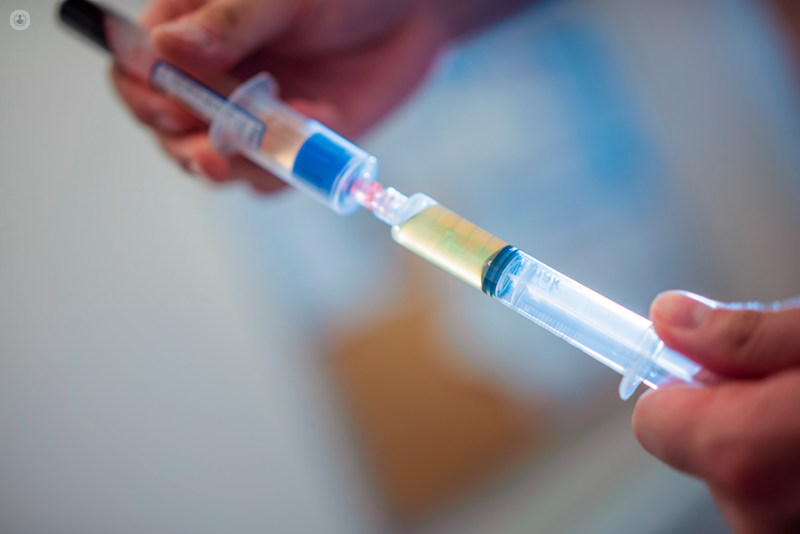What is PRP and how can it treat knee joint injuries?
Escrito por:Platelet rich plasma promises enhanced recovery from knee injuries and an alternative to surgery. However, it’s still an emerging treatment for knee injuries, so as a patient it’s important to understand how it works and how to navigate the options on offer.
We asked leading sports medicine specialist Professor Paul Lee the key questions: what conditions PRP can be used to treat? What treatments it can be combined with? And what patients should be aware of when choosing a clinic?

How did PRP emerge as a treatment for knee joint injury?
It is a known fact that there are growth factors and other signalling molecules such as cytokines in our blood. Due to its properties, blood serum has been used to treat many medical conditions for over 50 years.
PRP stands for platelet-rich plasma. Essentially it is the technique of separating and concentrating the useful substances that you find in your own blood, then injecting this into the area we want to treat.
What do we mean by “useful substances”? It depends on the condition we’re trying to treat. Some substances in the blood are ideal for improving the quality of your skin and making it look more youthful. Other substances can help to repair the cartilage in your knee. It is therefore essential to extract the right substances for the right condition. As a result, the PRP that we use to treat knee osteoarthritis, for example, is different to the PRP we use to treat acute meniscus tear.
What kind of knee conditions can PRP be used to treat? – (the devil is in the details)
PRP can be used to treat a wide range of knee conditions and injuries, including damage to the muscle, cartilage and meniscus. These are also known as soft tissue knee conditions.
However, effective treatment requires a solid understanding of the biology of the condition. Although it is true to claim that PRP can treat all these conditions, the devil is in the details when it comes to preparing the solution.
A good analogy is to say that all things with wheels can move you from A to B. However, you would not use a push bike to go from London to Grantham, if you are going to try to be there for a meeting before 8 am. It’s important to use the right tool. Yes, PRP can be used to treat most soft tissue knee conditions, but without proper application of knowledge and experience is it just pot luck.
Can it be useful to combine PRP with other treatments?
Depending on the need of the condition, PRP can be combined with other treatments:
- Combined with the appropriate hyaluronan, PRP can become a very powerful tool to treat osteoarthritis. The hyaluronan offers a neutral scaffold to support the cartilage, while the PRP can deliver signals to promote cells regeneration.
- PRP can be combined with surgery such as ACL, cartilage and meniscus repair to augment the patient’s recovery
- PRP can be combined effectively with (and enhance) cell therapy
What’s the current evidence base for this treatment?
Due to recent advances in medicine and the increased interest in biological solutions, the medical literature has expanded over a thousand times on the topic in PRP. There are now more than 5,000 methods to produce PRP, so it is very difficult to compare evidence across all of the studies.
There are level 1 clinical studies suggested that it is have great effects but at the same time that are also level 1 studies says it have no effects. To complicate the matters, meta-analyses (where we group the results of several studies together) conclude that PRP makes no difference.
This is no surprise, since each PRP treatment is different – grouping it all together makes no sense and will not produce a useful conclusion. It is like saying that antibiotics medication is not effective against infection. It certainly can be, as long as it is the right medication!
Properly practised PRP treatment should be knowledge and evidence-based. It is very important for the clinician to interpret studies relevant to the condition they are planning to treat and the preparation of the PRP they choose to prescribe. It is no different to any kind of medicine.
What should patients be aware of when choosing a clinic that offers PRP?
Choosing the right type of PRP should be down to the doctor – not the patient. It is unfair to ask patients to be informed about the different types of PRP available, as it takes specialist knowledge and training to decide which PRP is the best for the condition they have. We don’t ask our patient to google and choose their own antibiotics, so it shouldn’t be different with PRP.
That being said, I would suggest if at all possible, a close PRP system should be used to reduce the chance for infection. Currently I am using a 4th generation PRP system – its result is much more reproducible.
Finally, you can maximise the effectiveness of your treatment by reducing training and activities for at least 1 week following injection, and avoiding using anti-inflammatory drugs, as swelling is essential to the repair process.


